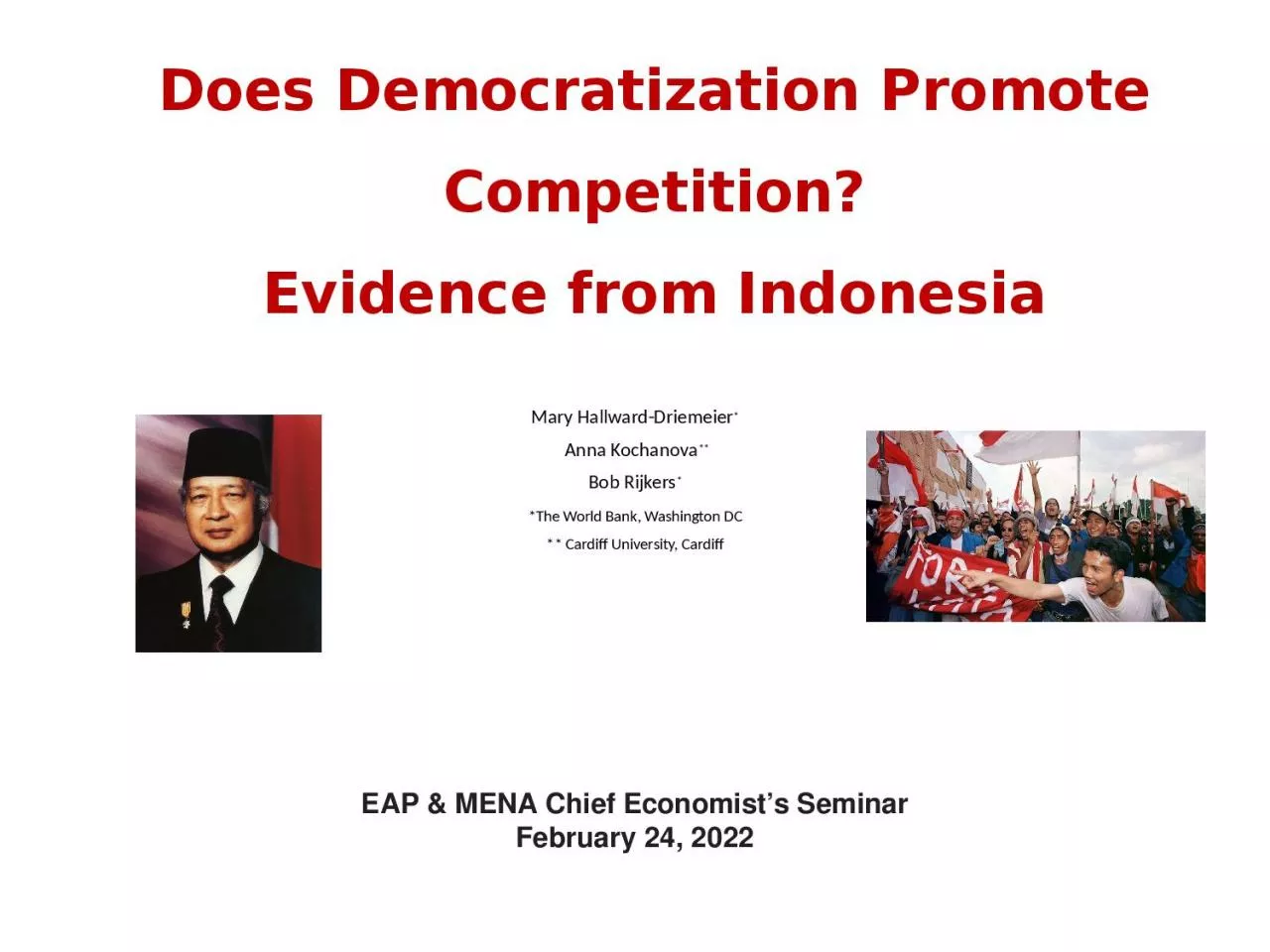

Evidence from Indonesia Mary HallwardDriemeier Anna Kochanova Bob Rijkers The World Bank Washington DC Cardiff University Cardiff EAP amp MENA Chief Economists Seminar February 24 2022 ID: 1002980
Download Presentation The PPT/PDF document "Does Democratization Promote Competition..." is the property of its rightful owner. Permission is granted to download and print the materials on this web site for personal, non-commercial use only, and to display it on your personal computer provided you do not modify the materials and that you retain all copyright notices contained in the materials. By downloading content from our website, you accept the terms of this agreement.
1. Does Democratization Promote Competition?Evidence from IndonesiaMary Hallward-Driemeier* Anna Kochanova**Bob Rijkers**The World Bank, Washington DC** Cardiff University, CardiffEAP & MENA Chief Economist’s SeminarFebruary 24, 2022
2. Motivation(How) Does Democracy Promote Growth? (Acemoglu et al., 2019; Papaioannou and Siourounis, 2008; Persson and Tabellini, 2006)Political Institutions impact incentives for firms to enter, invest and grow…....and shape the trade-off between protecting incumbents and promoting entry and demands for redistribution
3. Governance shapes competitionAutocracies Are more prone to corruption and capture by incumbents (Acemoglu, 2008; Treisman, 2000; Chowdhury, 2004)Democracies promote entry by constraining public corruption reduce regulatory protection for incumbent firmsRedistribute more (Adserà et al., 2003; Rose-Ackerman, 1999) Yet evidence on the impact of democratization on competition is limited
4. This presentationDoes democratization promote economic competition?Exploit the (unexpected) fall of the Suharto regime in 1998Did the severing of crony ties to Suharto led to enhanced competition in manufacturing sectors disproportionately exposed to cronyism?Epilogue: Tunisia after the Arab Spring
5. Main HypothesisMain hypothesis: disruption of political connections had a pro-competitive impact on Indonesian manufacturing industriescompanies connected to Suharto lose market sharemore competition in industries where Suharto connected firms accounted for a higher market shareIdentifying assumption: collapse of the Suharto regime reduced the value of connections to Suharto
6. Suharto Connections Lost Their ValueSuharto eraNews about Suharto’s HealthPost-Suharto eraNews About Wahid’s ImpeachmentStock price responses by Suharto dependence
7. Main findings (preview)Politically connected firms lost market share after Suharto’s fall, yet remained largeSuharto’s fall had a modest pro-competitive impact on industries in which his family had extensive business interests relative to industries in which they had not been important players
8. Context: Suharto eraCrony capitalismMechanisms of capture: licensing access to land and finance,tax breaks and subsidiespublic procurementmandatory partners in foreign venturesEast Asian Paradox rapid growth despite corruption, until the crisisSuharto resigned in May 1998
9. Context: post-Suharto eraMajor reforms: democratization, decentralization, and deregulationMany production and trade monopolies were eliminatedRestrictions on FDI were relaxedCompetition commission was established (KPPU) in 1999Reforms were often slow and piecemeal (Hadiz, 2004)
10. DataAnnual Manufacturing Survey (Central Bureau of Statistics of the Republic of Indonesia) Virtually all establishments with more than 20 employees, 1993-2009Data on industry, employment, output, value added, etc.Politically connected firms (Mobarak & Purbasari, 2006)Use event study of stock price reaction to bad news about Suharto’s health during 1994-1997 (cf Fisman, 2001)Find all subsidiaries of these connected companiesDistinguish between “family” and “cultivated” connectionsStock prices (Bloomberg)Information on entry regulations from Presidential Decrees
11. Connected firms matter
12. Connected firms matter
13. Connected (family firms) vs nonconnected firms
14. Connected firms sort into less competitive industriesHigher PC presence is associated withHigher outputLower (natural rate of) entryLower profit elasticityLower exports
15. IdentificationKey challenge: Isolate the impact of loss of political connections from the financial crisis and reformsWe exclude 1997-1999StrategiesDifference-in-difference and event study regressions: controlling for industry, year and district fixed effects, and firm and sector-characteristics.Triple-differences regressions: Exploiting the differential timing of the removal of the last Suharto appointed mayors across districts (Martinez-Bravo et al., 2017)
16. Firm-level Event Study – firm age, foreign and state ownership, exporter and importer status – external finance dependance, asset tangibility and entry regulation
17. Connected Firms lost Market ShareThe evolution of the market share premium on Suharto family connections
18. Triple-Difference Regression – how long a Suharto appointed mayor remained in office after Suharto’s removal (varies from 1 to 4)
19. The Suharto connectedness premium fell (insignificantly) more when regime change was suddenImpact of political turnover on market share – exploiting variation in the tenure of the last Suharto appointed mayors
20. Industry-level event studyentry and exit rates; the price–cost marginprofit elasticity;the Herfindahl-Hirschman index the market share of the four largest companies; the number of firms; prices; composite competition index Z combining all of the above (Kling et al., 2007) Controls: Aggregate foreign and state ownership,Aggregate import and export shares, Entry regulation, Dependence on external finance and asset tangibility
21. Dynamism improved – and margins fell
22. Concentration increased but prices fell
23. Competition Improved OverallComposite Competition IndexCOMBINES ALL COMPETITION INDICATORS
24. Robustness Tests Alternative proxy for political connections (e.g. broad connections)Adding 3-digit sector-year fixed effectsExcluding the most connected sectorsUsing time-varying controlsAdding controls for severity of the crisis
25. Reconciling the Evidence:Puzzle:Big impacts on firms vs limited impacts at the sector level Possible reasons:Nature of state-business relationships changed little:Democratization enabled ascendency of business interests into the political arenaPrivileges are firm- rather than sector-specificPath dependency: large firms remain large and were able to hold on to their dominant position even after initial privileges were removed
26. ConclusionSuharto’s fallsubstantially eroded the premium on being connected to himhad a modest but significant pro-competitive impact on industries in which his family had extensive business interests relative to industries that did notDemocratization can help curb capture, but, by itself, does not suffice to sustain competitive markets
27. Epilogue: Very Preliminary Results from Tunisia